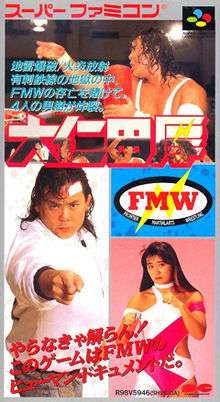Onita Atsushi FMW
 Cover art featuring Atsushi Onita and Megumi Kudo | |
| Developer(s) | Marionette |
|---|---|
| Publisher(s) | Pony Canyon[1] |
| Designer(s) | Yoshiro Akata[2][3] |
| Composer(s) | Takeshi Yasuda[4] |
| Platform(s) | Super Famicom |
| Release date(s) | |
| Genre(s) | Wrestling[1] |
| Mode(s) |
Single-player Two-player |
Onita Atsushi FMW (大仁田厚 FMW)[3] is a wrestling video game for Super Famicom. It was released on August 6, 1993 to an exclusively Japanese audience with an endorsement by Japanese professional wrestler and former Japanese politician Atsushi Onita.
Player have to fight their way through a fictionalised version of the Frontier Martial-Arts Wrestling organization; the wrestling promotion Onita owned, booked and was the star of throughout the nineties, portrayed in this game to be more of a tournament of the Street Fighter variety than a realistic wrestling company. According to the official slogan of the game, it was considered to incorporate an entire batch of innovative ideas. The instruction manual for the game talked about the virtual pursuit of achieving the total potential of each wrestler.[5]
Gameplay
The game is essentially a professional wrestling-style of video game that was remade into more of a "tournament" fighter. Each fight is a "death match" and seven of these must be fought in order to be crowned the champion. While this game feels like a Street Fighter II clone with a wrestling theme, it manages to capture the spirit of having the fighter with the best 2-out-of-3 rounds win the fight.
Players can use land mines that are the replicas used by the Imperial Japanese Army during the Second World War; these mines can blow a rock into pieces of dirt that fly up to 200 miles or 320 kilometres away from the blast site.[5] However, stepping on these land mines costs players a lot of their energy; re-enacting the hardcore matches of the FMW promotion in addition to Onita's typical matches.[3]
Each character has a gauge based on his spiritual strength (soul), physical strength (root), and mental strength (mind). The spirit of the player's characters can be recharged by getting the character to yell at the opponent.[5]
Wrestlers
Playable wrestlers
- Atsushi Onita
- Tarzan Goto
- Ricky Fuji
- Sambo Asako
- Megumi Kudo – hidden character
Non-playable bosses
- Ryuzo Yashajin
- Killer Marshalborg
- Knuckles Bomb
- Discover Love
- Giantonio Inoba
- Masked Bondage
- King Shadow
- Combat Toyoda - opponent in Megumi Kudo's hidden match
References
- 1 2 3 "Release information". GameFAQs. Retrieved 2011-06-09.
- ↑ "Designer information". SMS Power. Retrieved 2012-12-27.
- 1 2 3 "Designer information/title translation". SuperFamicom.org. Retrieved 2012-12-27.
- ↑ "Composer information". SNES Music. Retrieved 2012-07-18.
- 1 2 3 "Basic gameplay information". AtWiki. Retrieved 2012-12-26.